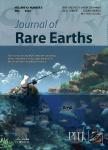A comparative DFT+U study of CO oxidation on Pd-and Zr-doped ceria
作者机构:Key Laboratory for Advanced Materials and Joint International Research Laboratory for Precision Chemistry and Molecular EngineeringFeringa Nobel Prize Scientist Joint Research CenterFrontiers Science Center for Materiobiology and Dynamic ChemistryCentre for Computational Chemistry and Research Institute of Industrial CatalysisSchool of Chemistry and Molecular EngineeringEast China University of Science and TechnologyShanghai 200237China
出 版 物:《Journal of Rare Earths》 (稀土学报(英文版))
年 卷 期:2023年第41卷第7期
页 面:1042-1048,I0003页
核心收录:
学科分类:083002[工学-环境工程] 0830[工学-环境科学与工程(可授工学、理学、农学学位)] 081705[工学-工业催化] 08[工学] 0817[工学-化学工程与技术] 080502[工学-材料学] 0805[工学-材料科学与工程(可授工学、理学学位)]
基 金:Project supported by National Key R&D Program of China(2018YFA0208602) National Natural Science Foundation of China (21825301,22003016,92045303) the Fundamental Research Funds for the Central Universities(222201717003) Shanghai Municipal Science and Technology Major Project(2018SHZDZX03) the Programme of Introducing Talents of Discipline to Universities (B16017)
主 题:CeO_(2) Metal doping CO oxidation Carbonate DFT+U Rare earths
摘 要:Metal-doped ceria catalysts have been applied in many important catalytic *** this work,we performed density functional theory calculations corrected by on-site Coulomb interactions to study the Pd-and Zr-doped CeO_(2)(111) surfaces with the dopant at different *** formation of oxygen vacancies and CO oxidation were systematically calculated on the various doped *** find that both Pd and Zr doping can activate the surface lattice O and reduce the energy barriers of CO ***,the promotion effect of the Zr dopant is limited to its existence in the first surface layer,while for the Pd dopant,the surface activity can be greatly enhanced even it occurs far below the ***,CO_(2) can be generated directly on the Pd-doped surfaces through reaction between CO and surface O,while the surface intermediate CO_(2)^(δ-) may readily form and restrict the releasing of CO_(2) by further oxidation to carbonates on the Zr-doped *** analyses show that the doped Pd exists as Pd^(4+) and it has stronger electron affinity than other surface species during CO oxidation,contributing to the easy Pd^(4+) to Pd^(2+) transformation accompanied by direct CO_(2) formation at Pd-doped ceria.



